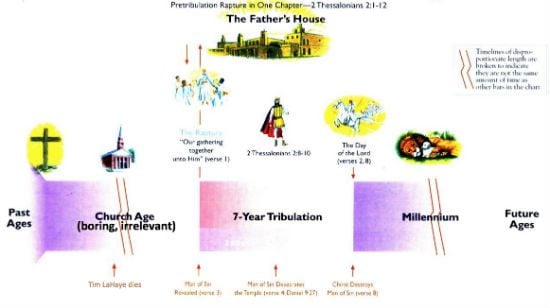Daniel Radosh stumbled into what he calls “the parallel universe of Christian pop culture,” and I for one am glad he did.
Radosh’s wonderful book Rapture Ready chronicles his travels through this strange land with a generous spirit and a perceptive eye. He sees things as they are and understands what they mean. Much of what he sees is awful, misguided or unintentionally hilarious, but Rapture Ready is marked less with scorn and ridicule than it is with a sincere affection and desire to understand the strange citizens of this oddball subculture.
In one early chapter, Radosh visits the CBA — the annual trade show for what used to be called the Christian Booksellers Association. The CBA is always a vast and appalling spectacle, acres of tasteless merchandise and absurdly inept “witnessing tools” — from Testamints to the latest offensive T-shirts. Just about every year somebody writes an article cataloguing the absurdities of the CBA and just about every year it seems like the same article — the same condescending tone, the same easy shots at these fish in a barrel. “Get a load of these freaks” is the general idea. Radosh doesn’t recycle that article or that attitude. He recognizes that 95 percent of what he’s seeing is crap, but he remembers Sturgeon’s Law — “95 percent of everything is crap” — and keeps his eye out for that other 5 percent.
Radosh’s comments on both — the sea of crap and that sometimes well-hidden 5 percent — are insightful. When he stumbles across something called the “Smiling Cross,” for example, he notes:
Radosh’s wincing discomfort there will be familiar to anyone who has spent time living in America’s evangelical subculture. And he identifies the source of that discomfort precisely: the embrace of tasteless sacrilege as the symbol of devotion. Yes, the Smiling Cross is tacky. But it is also worse than tacky. Being tacky is the least of its problems.
In the course of his book, Radosh also examines every nook and niche of Christian pop culture he can find, from Christian rock and music festivals to Christian skaters and Christian fiction. Throughout his travels in this parallel universe, he manages to locate and interview some of the sharpest and most insightful critics of the subculture. At this point it becomes hard for me to be objective, since we used to publish those same critics regularly back in the day at Prism magazine. For those of you who remember those early years of Prism, let me say that Rapture Ready seems almost like the book that Dwight Ozard always talked about writing some day. For those of you who don’t remember Dwight, let me say that I mean this as a very high compliment.
And I hope you won’t discount that compliment when you learn that it’s reciprocal. In discussing the realm of “Christian fiction,” Radosh of course had to grapple with the Vegas Elvis of the genre, the Left Behind series. And in addressing that subject, he had some nice things to say about this blog:
If nothing else, you might think the sudden disappearance of every child on earth would have some implications for society, or at least for their parents, but LaHaye and Jenkins can’t concern themselves with this, because John Nelson Darby said that once the tribulation begins, certain events must happen on a fixed timetable, and damn it, they’re going to follow that schedule. “The authors behave as they imagine God behaves,” Clark writes. “They have a plot that must move forward, and they will advance that plot even if it means causing, then callously disregarding, the suffering of billions of people. Plot trumps — and tramples on, and violates — character. Here, once more, Bad Writing and Bad Theology intersect.”
That’s very kind, and I quote it here because I am, of course, an egomaniac. But there’s actually another very perceptive passage about Left Behind that I want to bring to our attention here, because I think it touches on why I want to continue with LB Fridays, plowing on through the books and the movies and — if the Lord tarries — the whole wretched series.
Radosh notes that while the series continues to be phenomenally successful and influential, it has also been quite a while since the first book was published:
While the political and theological influence of Left Behind will be felt for many years to come, its status as a pop-culture icon has largely come to an end. The first book came out in 1995, long enough ago that some of the real people who make cameo appearances in its future world are now dead in the real one, and some of its futuristic technology is obsolete. As I discovered when I asked Christians about it, the secular world’s continued fascination with Left Behind is seen as a sign of how out of touch we are with evangelical culture. …
All true. And a good argument, perhaps, for why we might consider moving on to some more recent, more current trend. But I don’t think we’re done yet with the World’s Worst Books.
For one thing, as Radosh points out, these books “political and theological influence … will be felt for many years to come,” and I don’t want to allow that influence to go unchallenged. These books are responsible for leading many evangelical Christians to embrace sacrilege as a form of devotion, and as long as that continues to happen, I want to argue against it. And while the political influence of End of Days theologies may not be at its highpoint, this dangerous and disastrously irresponsible outlook continues to shape the politics of millions of Americans and so there’s still plenty of work to be done countering that as well.
But I don’t think of LB Fridays as being only about “evangelical culture.” The Left Behind books are an American artifact, and as such they provide a window into many, many aspects of American life. Their unfailing, bottomless awfulness remains fruitfully instructive and continues to serve as a platform for peering into a vast myriad of America’s mistakes, misfits and misapprehensions. As long as working our way through these books continues to be so fruitfully instructive, then I’m all for forging ahead.
If that makes me a bit “out of touch with evangelical culture,” well, I’m OK with that.
So next week, then:












